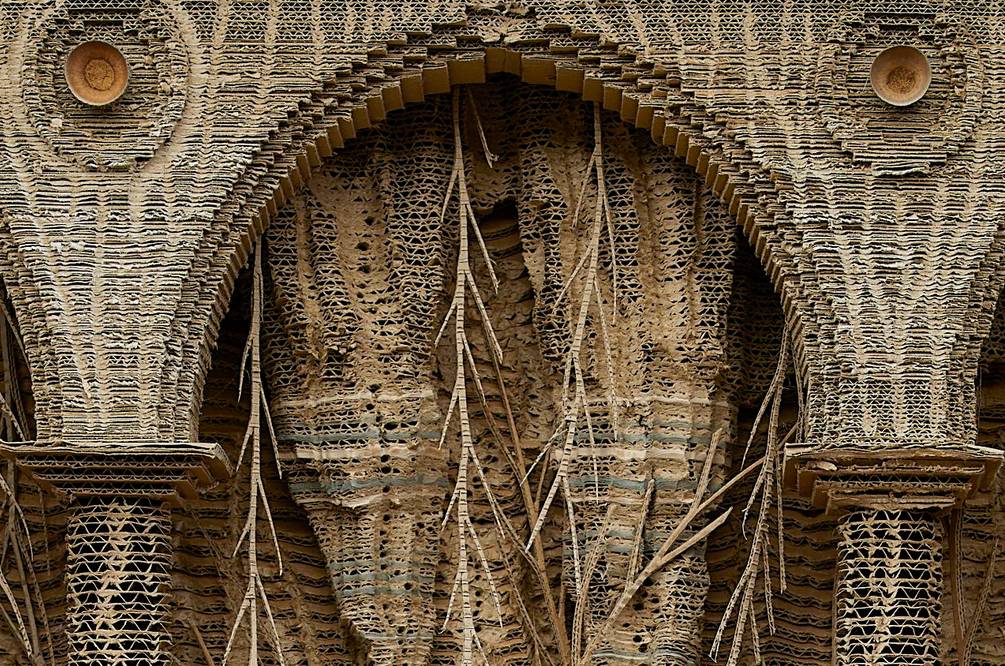
Eva Jospin
Folies
Exhibition
-> May 19 2023 – Sep 9 2023
Mariane Ibrahim
Eva Jospin is a French artist known for her unique approach to sculpture, creating exquisite and intricate cardboard landscapes that explore the relationship between nature and culture while challenging our perceptions of materiality. Folies, the artist's inaugural exhibition with the gallery and her first in Mexico, reveals the breadth of Jospin's practice and represents the formal, material, and conceptual culmination of her work to date. Featuring an immersive site-specific installation and a series of new drawings, sculptures, and silk tapestries, the exhibition presents beautiful and bizarre depictions of caves, forests, and architectural ruins that evoke the sublime, the supernatural, and even the magical. The title of the exhibition, Folies, refers both to Jospin's fascination with “follies” - lavish ornate buildings popular during the 18th and 19th centuries in English and French gardens or parks that served no practical purpose - and to the French root of the English word "foliage" (foliage).
Man-made in the midst of nature, traditional follies are picturesque symbols of extravagance designed in the likeness of classical architecture - often ruins of Greek and Roman temples and Gothic towers - to create spaces where fantasy can unleash. The centerpiece of Jospin's exhibition, Galleria (2022), is an immersive installation that works similar to a "folly" by completely transforming the white walls of a gallery room into an otherworldly, almost post-human setting. where trees, roots and rock formations are mixed with columns, arches and classic niches. Comprised of intricately carved layers of corrugated cardboard, Galleria stands in the liminal space between the vegetal and the architectural, the intentional and the accidental, the elegant and the disconcerting. The monochrome installation is disturbed by splashes of color in the tapestries, drawings, and miniature landscapes found within the niches. Like the proto-cinematic wonder of traditional follies, Galleria sets the stage for the viewer to escape into their own curiosity and imagination.
Although the “follies” are mainly built with traditional materials such as stone, marble or brick, the material chosen by Jospin is one that embraces fragility and temporality. After studying drawing, painting, and sculpture at the École Nationale Supérieure des Beaux-Arts, Jospin turned to cardboard as a primary material for its accessibility, versatility, malleability, and connection to everyday life. He was especially interested in the fact that it was a humble material that, while used around the world, is often overlooked and thrown away as waste. Folies presents a series of sculptures that reflect the natural world and demonstrate the wide range of uses that Jospin makes of his chosen material. In Grotte (2023), the artist creates a diorama of a vaulted Italian Baroque structure that has been carved directly into the rock of a cave. The interior walls are adorned with meticulously carved vines, colorful paper accents, and shell, stone, and brass inlays. The level of detail Jospin achieves through sanding, cutting, and carving transforms the cardboard into sharp rock faces, ornate moldings, intricate wood grain, and tangled vines and branches.
Similar to assembly, Jospin uses additive rather than subtractive techniques that complicate dimensionality. 2 Forêts (2023) is a large-scale panorama of a barren forest wedged between two sheer rocky cliffs. Composed entirely of cardboard, the simulated forest, rock, and stratified layers of soil and root systems of the base are carefully constructed to resemble nature. Cardboard collage, despite being a humble material, has served as the basis for experimentation in some of the most significant historical art movements. For example, the Cubists of the early 20th century used cardboard and assemblage to challenge the limited one-point perspective that had dominated representation since the Renaissance. Jospin's manipulation of the material exemplifies her ability to deal simultaneously with illusion and reality through trompe l'oeil effects. From a distance, the work looks like an exact replica of a forest; however, Jospin often leaves some elements of the corrugated board intact, and on closer inspection, the sincerity of the texture shatters the illusion. The effect is dizzying when one tries to distinguish the material, dimensionality and construction of a perceived reality.
Although he employs recognizable motifs from the natural and built environment, Jospin's accuracy sheds light on his ability to transform ordinary, ephemeral material into alluring, surreal environments. The space between the real and the fictional, the familiar and the unusual is where Jospin's work thrives. The artist has explained that "my work is figurative, but it is not an illustration; it is a composite, which is a bit of everything". The composite nature of the works invites one to distance oneself sufficiently from an original reference to allow the viewer to use their own imagination, memories and dreams. In the silk embroideries and drawings featured in Folies, Jospin delves further into the playful imaginary possibilities of nature. Galleria, an embroidery of silk thread on silk canvas depicts Jospin's own constructed world in ruins. In this illustration, the walls of the Galleria sculptural installation are being invaded by the natural elements: vines, trees, rocks. The drawings and embroideries function as echoes or ghosts of their sculptural counterpoints, further blurring the border between the real and the fictional.
Occupying the spaces in between -drawing and sculpture, nature and artifice, the beautiful and the unusual-, Folies' works function like folklore or fairy tales. Jospin comments: "I'm interested in the fact that we need to create imaginary worlds to understand the real one." In traditional folklore and fairy tales, nature (often the forest) serves as a fantastic setting for life lessons, warnings, or tales of human transgressions. Jospin amplifies ambiguity as a tool to capture the spirit of illusion in his work and, like folklore, invites experiences that span the sweet and joyous, the ominous and terrifying.
— Anna Stothart, independent curator